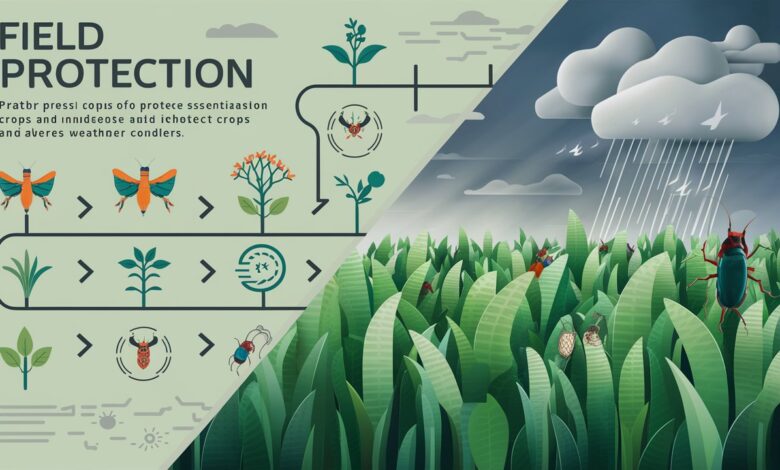From Pests to Weather: Essential Tips for Safeguarding Your Fields

Farming is a balancing act between nurturing crops and defending them from a wide range of threats. From tiny insects to unpredictable weather patterns, your fields face daily challenges that can harm yields and put your hard work at risk. The good news is that with the right strategies, you can protect your crops, minimize losses, and secure a healthier harvest. Let’s explore some essential tips for safeguarding your fields against both pests and weather.
-
Understand the Risks Facing Your Fields
The first step in crop protection is knowing what you’re up against. Different regions and crop types are vulnerable to specific threats:
- Pests: Insects, rodents, and even birds can damage leaves, roots, and fruits.
- Diseases: Fungal, bacterial, and viral infections spread quickly if unchecked.
- Weather Extremes: Drought, flooding, frost, and heat waves can devastate yields.
Regularly monitoring your fields and staying informed about seasonal risks in your area helps you prepare in advance instead of reacting after damage occurs.
-
Practice Integrated Pest Management (IPM)
Instead of relying only on chemical pesticides, integrated pest management combines multiple methods to keep pest populations under control. This includes:
- Crop Rotation: Rotating crops each season disrupts pest life cycles.
- Biological Controls: Introducing beneficial insects like ladybugs or lacewings that feed on harmful pests.
- Targeted Spraying: Using pesticides only when necessary and in precise areas to reduce chemical resistance and environmental impact.
IPM not only safeguards your crops but also supports healthier soil and biodiversity on your farm.
-
Build Strong Soil Health
Healthy soil is the foundation of strong, resilient crops. Practices such as adding organic matter, reducing tillage, and planting cover crops improve soil structure and fertility. When crops grow in nutrient-rich, well-aerated soil, they are better equipped to withstand pests and resist diseases. Additionally, soil with good water retention helps reduce the impact of drought or heavy rainfall.
-
Use Protective Barriers and Physical Defenses
Sometimes, the most effective protection for your crops comes from straightforward physical barriers. Depending on your crop needs, you could consider:
- Row Covers or Netting: These shield your plants from insects, birds, and intense sunlight.
- Windbreaks and Shelterbelts: Planting trees or shrubs along the edges of your fields can reduce wind damage and prevent soil erosion.
- Fencing: Working with fence contractors in Salt Lake City allows you to install durable fences that keep out larger pests and animals, providing a reliable perimeter defense.
- Mulching: Applying organic or synthetic mulch helps retain soil moisture, suppress weeds, and regulate temperature around your crops.
These strategies are cost-effective, environmentally friendly, and help minimize reliance on chemical treatments while safeguarding your harvest..
-
Plan for Weather Extremes
Climate change has made weather more unpredictable, so preparing your fields for extremes is crucial:
- Drought Protection: Invest in efficient irrigation systems such as drip irrigation that deliver water directly to roots while conserving resources.
- Flood Prevention: Create proper drainage systems to prevent waterlogging and root rot during heavy rains.
- Frost Protection: Use frost blankets, sprinklers, or wind machines to protect sensitive crops during unexpected cold snaps.
Being proactive ensures your crops have a fighting chance against nature’s extremes.
-
Diversify Your Plantings
Relying on a single crop makes your farm more vulnerable. By diversifying crops, you reduce the risk of total loss if pests or weather hit one type particularly hard. Intercropping—planting different species together—can also confuse pests and improve soil health by balancing nutrient use.
-
Stay Updated with Technology
Modern farming offers powerful tools for crop protection. Remote sensors, weather forecasting apps, and drones allow farmers to monitor fields more closely and respond quickly to threats. Precision agriculture technology helps optimize fertilizer and pesticide use, reducing costs while protecting crops more effectively.
-
Keep Records and Learn from Each Season
Every season provides valuable lessons. Keep detailed records of pest infestations, weather patterns, crop performance, and the effectiveness of different protection methods. Over time, these insights help you make smarter decisions and anticipate recurring challenges.
Final Thoughts
Safeguarding your fields isn’t about eliminating every risk—it’s about managing them wisely. By combining time-tested practices like crop rotation and mulching with modern technology and smart planning, you can build resilience into your farming system. Protecting your crops from pests and weather not only ensures better harvests but also helps secure the long-term sustainability of your land.
Your fields are your livelihood, and with the right strategies, you can face each season’s challenges with confidence.




